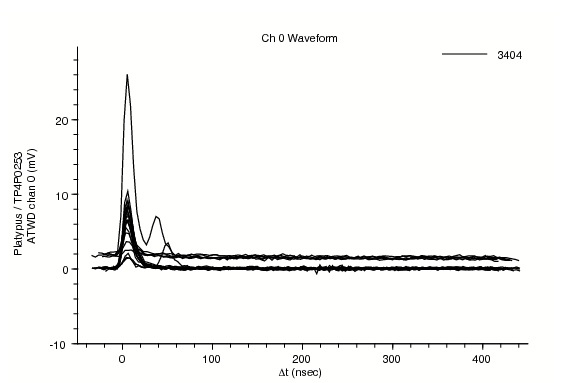
John Kelley, September 2006
Jim Braun discovered in early 2005 that there exists a bimodality in the ATWD baseline which is not accounted for by DOM-Cal's calibration. This shift in the baseline varies from waveform to waveform, and if not correctly accounted for, can result in erroneous charge integration because of the waveform offset.

Figure 1: Bimodal baseline waveforms (calibrated TestDAQ data, FPGA build 409)
Further investigation (see Jim's page) revealed that the baseline bimodality only appears in local coincidence (LC) mode when there are hits present that are not fully digitized and read out by the FPGA (in FPGA jargon, they experience an "LC abort"). This LC abort is responsible in some way for shifting the baseline of the next hit.
Dave Seckel also demonstrated with a thorough investigation [bartol.udel.edu] that this effect is present in realDAQ data as well. He also observed that there are other undesirable features of the shifted waveforms, such as increased noise, and a "hook" at the end of the waveform.
This hypothesis was verified by hacking a version of the FPGA which eliminates the LC abort -- hits with no LC still are not read out of the DOM into the data stream, but they are always digitized by the FPGA. This eliminates the baseline shift:

Figure 2: Sample waveforms with FPGA test build 413
However, this solution will add some amount of deadtime. The following plot shows a Monte Carlo estimate for the deadtime fraction as function of noise rate and deadtime per ATWD hit, assuming ping-ponging:

Figure 3: Deadtime fraction with ATWD ping-ponging
Investigations are ongoing to determine if there is a more elegant solution in the FPGA that will still eliminate the baseline shift.